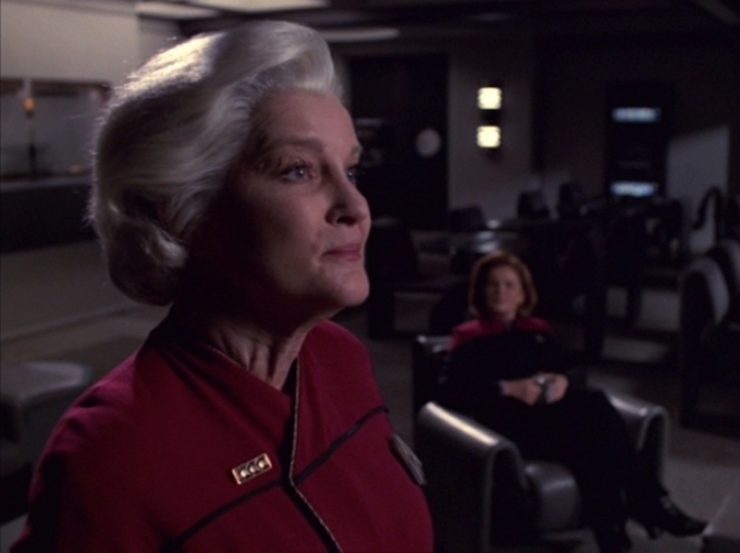“Endgame”
Written by Rick Berman & Kenneth Biller & Brannon Braga and Robert Doherty
Directed by Allan Kroeker
Season 7, Episode 25/26
Production episode 271
Original air date: May 23, 2001
Stardate: 54973.4
Captain’s log. In 2404, Voyager is celebrating the tenth anniversary of her return home after twenty-three years in the Delta Quadrant. Admiral Janeway attends a party that also includes Captain Kim (CO of the U.S.S. Rhode Island), Commander Barclay (a teacher at the Academy), Torres (a Federation-Klingon Empire liaison), Paris (a holonovelist), the EMH (now married and having chosen the name Joe), and Naomi and her daughter, at the very least.
Not present is Tuvok, who is institutionalized thanks to a brain disorder that can only be cured by a mind-meld with a biologically compatible Vulcan. There was no such Vulcan on Voyager, unfortunately. Also not present are two who died: Chakotay and Seven. And another absence is Ensign Miral Paris, the daughter of Paris and Torres, who is on a special mission for Janeway.
Torres also informs Janeway that she has arranged for a Klingon named Korath to get a seat on the High Council.
Barclay teaches a class on the Borg at the Academy, and Janeway comes as a guest lecturer. One cadet asks about the Unimatrix Zero rebellion, and another asks about Seven—Janeway shuts the latter down quickly. A call from Miral interrupts the class—she’s arranged a meeting with Korath, and he insists on meeting Janeway personally.
Janeway then surprises Joe by requesting her annual physical ahead of time—usually the doctor has to put her in a headlock to get her to get an exam. She also asks Joe for two thousand milligrams of an experimental drug that protects one from tachyon radiation.
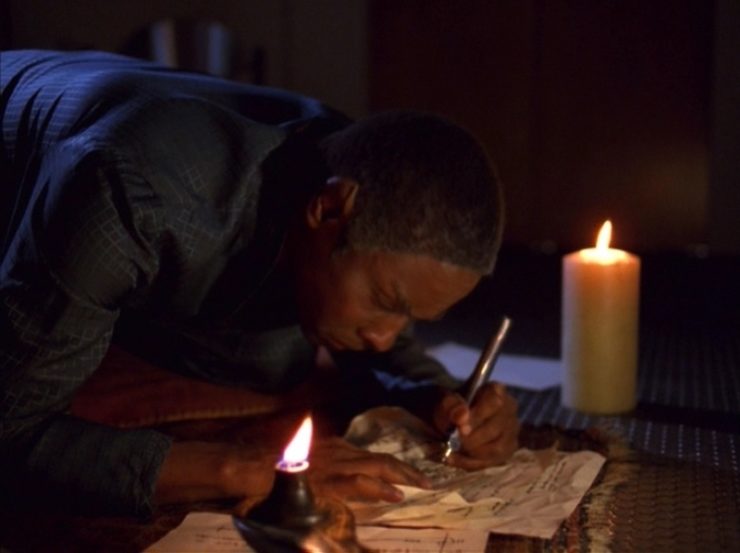
She also visits Tuvok in the institution—he is not well, scribbling notes on pieces of paper by candelight, even though his hospital room has safer light sources he can use. Janeway indicates that she’s taking a trip she doesn’t plan to come back from. Then she visits Chakotay’s grave.
Finally, Barclay provides her with a shuttle and some information on a padd. He also offers to go with her, but she refuses.
In 2377, Torres has the latest in a series of false labors, to the chagrin of both her and Paris. Meanwhile, Kim has started a pool for when the kid will be born. Voyager detects a nebula that is filled with wormholes. They go to investigate, but stumble across a Borg Cube—which turns out to be one of many. They seem to escape without attracting the Borg’s notice, but it’s a near thing. Despite the pleadings of Kim, they move on from the nebula.
Icheb plays a game of kal-toh against Tuvok and wins. This indicates to Tuvok that his condition is worsening, and the EMH ups his medication. Tuvok also refuses to discuss this with the captain until such time as it affects his on-duty performance.
Meanwhile, Chakotay and Seven have started dating. They have a picnic lunch in the cargo bay, which we learn is their third date.
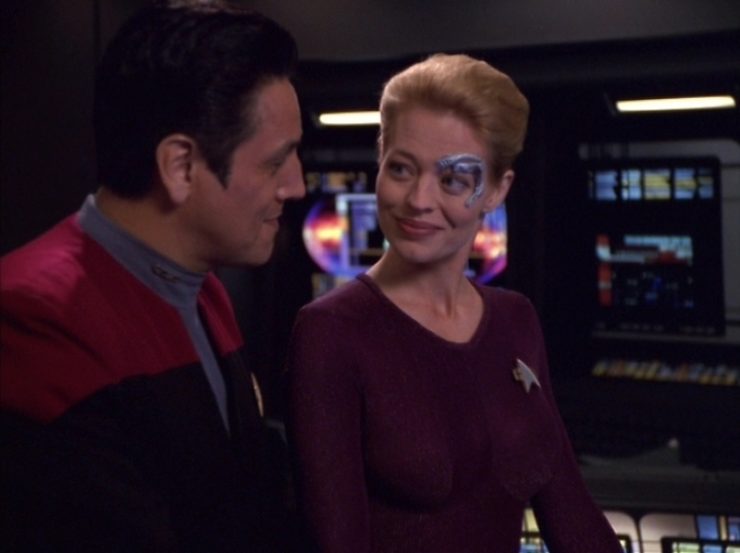
In 2404, Joe’s presence is requested in Tuvok’s room at the hospital: he’s agitated, constantly reciting a stream of numbers and saying that Janeway’s disappearance remains a mystery. Joe then confronts Barclay, who finally admits that Janeway has gone off on an unauthorized mission. Joe gets in touch with Kim.
Janeway arrives at a planet and beams down to a cave. She dismisses Miral, who objects—she’s been working on this for six months—but Janeway insists she go see her parents who miss her. Janeway then meets with Korath, who has a time-travel device for her as promised—but now he wants her shield generator as additional payment. Janeway initially refuses, then pretends to give in, contriving to steal the device.
In 2377, Chakotay and Seven have another date, and then Seven goes to the EMH to ask him to fix her cortical node so it won’t render her unconscious if she gets too emotional. The EMH thinks that he’s in, there, but she gently rebuffs him, saying she’s involved with someone else.
In 2404, the Rhode Island shows up, with Kim intending to arrest Janeway. However, she instead manages to talk him into helping her with her plan. She hooks up the device and prepares to use it. However, Korath shows up and fires on her. The Rhode Island provides cover, while the shuttle goes through a temporal rift.
The shuttle winds up in 2377 and in the Delta Quadrant. Admiral Janeway instructs her younger self to close the rift before the Klingons get through, which she does.
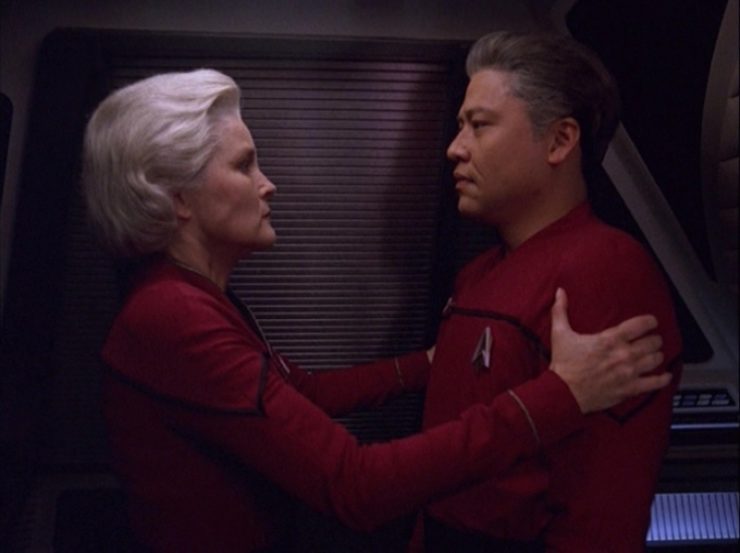
Admiral Janeway explains that she’s here to get Voyager home sooner, but doesn’t explain why for Temporal Prime Directive reasons. The EMH confirms that it is indeed an older Kathryn Janeway, and Seven confirms that the shuttle is Starfleet, but more advanced, with weaponry and defenses that might well be effective against the Borg.
Janeway agrees to make the modifications to the ship to defend better against the Borg and then return to the nebula.
Buy the Book


Until the Last of Me
Seven goes to regenerate, at which point the Borg Queen contacts her. She says that she knows full well that Voyager entered the nebula, but she left them alone as a kindness to Seven. But if they return, there will be no such kindness.
Admiral Janeway dismisses the threat, because the fancy-shmancy new weapons will enable them to stand fast against the Borg.
They go into the nebula and the new armor defends against all Borg weapons and the transphasic torpedoes destroy a Cube. The Borg Queen backs off, not willing to sacrifice so many drones to stop one ship.
Voyager arrives at the center of the nebula, which reveals one of the Borg’s six transwarp hubs.
Janeway immediately orders Paris to fly out of the nebula. This is a major tactical advantage the Borg have, and now they can cripple them. Admiral Janeway is livid, but Janeway insists that they find a way to destroy the hub.
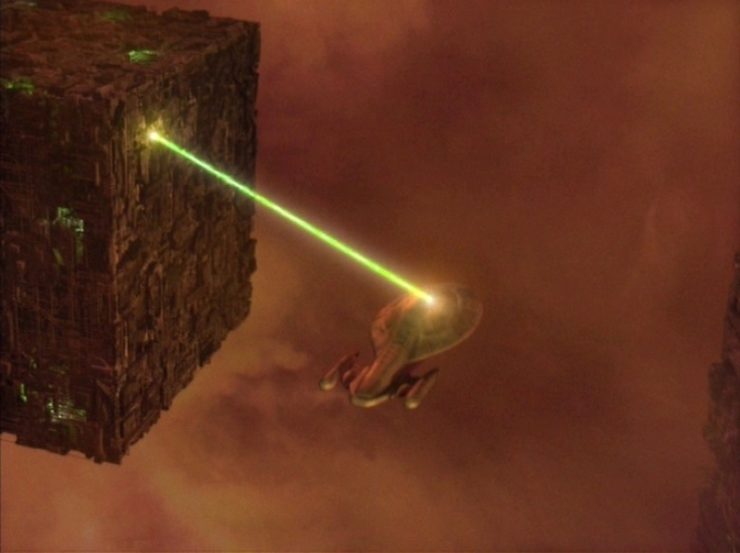
In private, Admiral Janeway finally tells the whole story: Seven will die if they don’t get home now, and so will twenty-two other people, though they’re just an afterthought, what with not being opening-credits regulars and all. Plus Tuvok’s condition will deteriorate—a condition that Janeway doesn’t even know about yet.
Tuvok insists that his condition is a worthy sacrifice to make in order to save all the lives that would go unassimilated if they destroy the hub. Admiral Janeway then breaks the Temporal Prime Directive even further by telling Seven the truth about what will happen to her, but she also feels that her life is worth sacrificing to destroy the Borg hub. Having said that, she also breaks things off with Chakotay to spare him the heartbreak of losing her.
Tuvok and Seven come up with a plan to detonate multiple transphasic torpedoes, which will have a cascade effect and destroy the hub. Voyager will have all of ten seconds to get away. Janeway, remembering that they were stranded in the Delta Quadrant in the first place to save the Ocampa, says that she won’t order the crew to do it, she’ll only give the order if they all agree. They all do, with Kim of all people giving a rousing speech about how it’s the journey that matters rather than the destination.
The two Janeways then have a conversation, with Admiral Janeway appreciating the reminder of how close the crew was and how loyal they were to her. (Given that she got Barclay and Kim to help her out knowing what she was doing, I don’t see how she could possibly forget that, but whatever…) They also come up with a plan to eat their cake and have it too: destroy the hub but not until after they get home.
Admiral Janeway gets an injection of something that will probably be important later, then goes off in her shuttle. Voyager heads into the nebula, just as Torres finally goes into labor. Paris reluctantly leaves his wife’s side, with her blessing, as they need their best pilot if they’re going to survive.
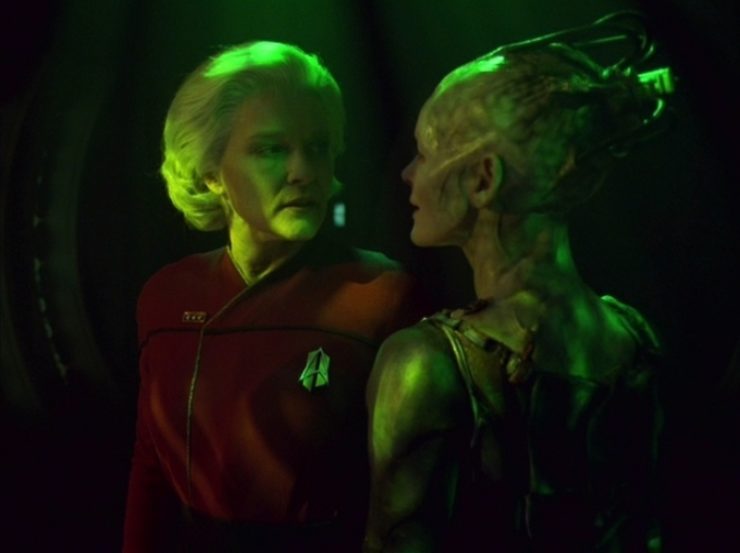
The Borg Queen sees that Voyager is entering the nebula, but then Admiral Janeway appears before her: it’s a neural projection, using fancy-shmancy twenty-fifth-century technology. Admiral Janeway offers to provide the Queen with information on how to defeat the futuristic defenses if the Queen allows Voyager to go home. The hub will then remain intact. The Queen asks for the admiral’s shuttle, also, which she reluctantly agrees to—but then the Queen announces that they’ve traced her signal. The Borg beam Admiral Janeway into the Queen’s chamber and the Queen assimilates her.
Just as Voyager is about to enter the hub, the Queen orders Cubes to go after them and assimilate them—but then she collapses. The injection the admiral got earlier was a pathogen that infects the Collective. It eventually destroys all the Cubes in the nebula, which destroys the hub.
However, the Queen did manage to divert one sphere that was already in the hub to Voyager. It chases them to the Alpha Quadrant, where Owen, Barclay, an admiral, and some other ships watch in fear, a fleet of ships sent to defend Earth against what looks like a Borg attack.
But Janeway had Paris maneuver inside the sphere and then Tuvok detonates a transphasic torpedo. Voyager triumphantly flies out of the exploding sphere, and are welcomed home by a shocked Owen.
Meanwhile, down in sickbay, Torres gives birth to a bouncing baby girl.
And Voyager heads toward Earth.
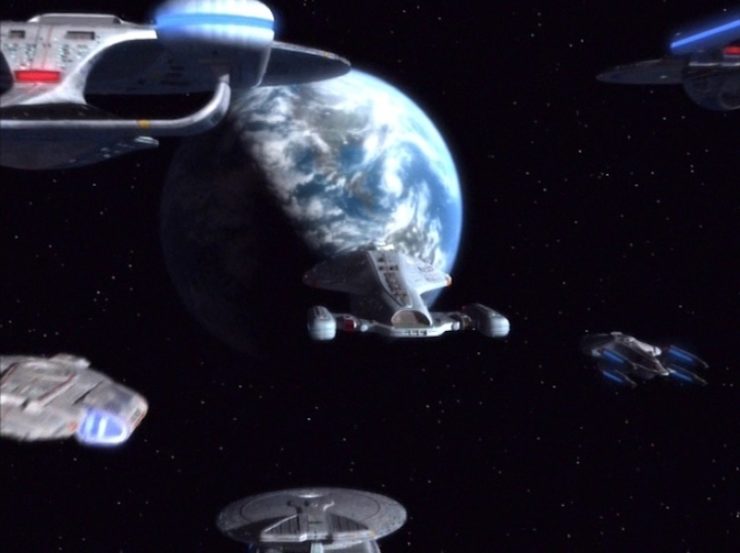
Can’t we just reverse the polarity? Apparently transphasic torpedoes are even more super-duper than photon and quantum torpedoes.
There’s coffee in that nebula! Janeway, not satisfied with getting her crew home in twenty-three years, is determined to risk the space-time continuum by getting them home in seven, mostly so her surrogate daughter won’t die.
Mr. Vulcan. Tuvok has been dealing with a degenerative neurological condition, one that resulted in his being institutionalized in 2404, but which presumably was taken care of by a family member once they got home in 2377.
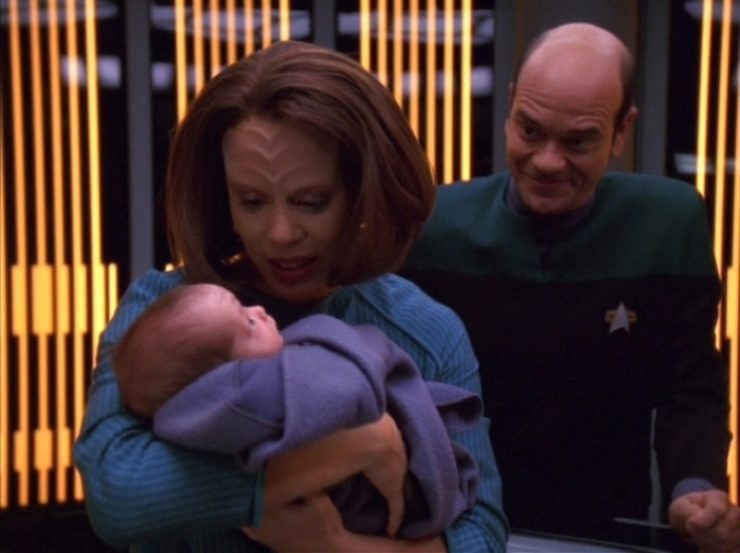
Half and half. Torres is not happy about all the false labors, nor the EMH’s comment that Klingon labors can sometimes go on for days. She is also hilariously cranky when Paris realizes that he might win the baby pool.
Forever an ensign. In 2404, Kim finally got promoted, all the way to captain! In 2377, he goes from whining about not checking out the nebula—even trying to inveigle Paris to go with him in the Delta Flyer to investigate more covertly—to giving a speech how it doesn’t matter when they get home, as long as the family stays together.
Everybody comes to Neelix’s. Neelix is still in touch with the ship. He and Seven are playing a long-distance game of kadis-kot, and Neelix is aware of Seven and Chakotay’s burgeoning relationship.
Chell is vying for the job of replacing Neelix as ship’s chef, and his dishes include Plasma Leek Soup, Chicken Warp Core-don Bleu, and Red Alert Chili.
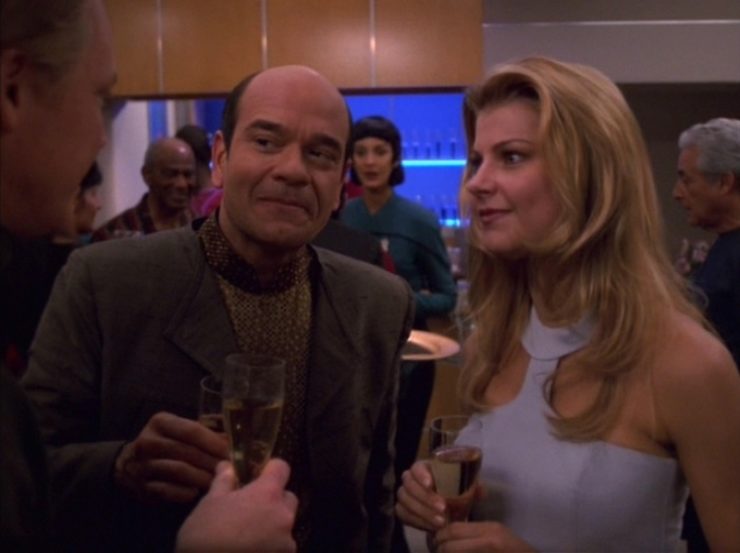
Please state the nature of the medical emergency. In 2404, the EMH has a name and an organic wife. He’s also the one who figures out what Janeway is up to and tries to stop her. In 2377, he tries to get the admiral to tell him about his future self’s accomplishments, before the captain shuts his inquiry down.
Resistance is futile. Seven is on her way to becoming more human, and also is the one whom the Queen contacts to make them aware that they’re in bigger trouble than they think, and also helps devise the plan to destroy the hub.
No sex, please, we’re Starfleet. In 2377, Chakotay and Seven have started dating, which was vaguely hinted as a possibility in “Human Error.” In the alternate future, they got married, and Seven’s death devastated Chakotay.
Neelix says that he’s thinking of asking Dexa to marry him.
Do it.
“It took you thirty-three years to come up with ‘Joe’?”
–Paris expressing shock at the EMH’s very slow road to picking a name.
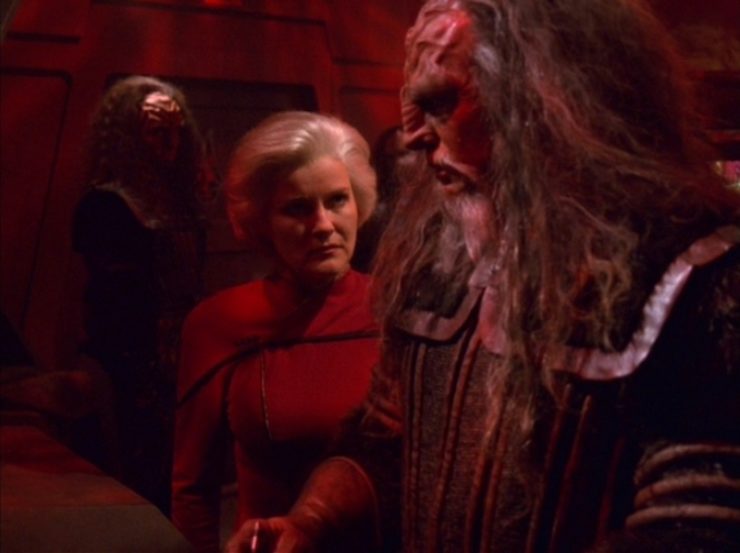
Welcome aboard. Alice Krige returns to the role of the Borg Queen; she last played the role in First Contact, but Susanna Thompson had played her on her prior Voyager appearances (“Dark Frontier” and the “Unimatrix Zero” two-parter). Krige will next appear in the role in Lower Decks’ “I, Excretus,” where the Borg Queen is part of a holodeck exercise.
Lisa LoCicero plays Miral; she’ll return to voice the character in Star Trek Online.
Miguel Perez plays Tuvok’s doctor, Grant Garrison and Iris Bahr play two of Barclay’s cadets, Amy Lindsay plays the EMH’s wife Lana, Matthew James Williamson plays the obnoxious Klingon, Ashley Sierra Hughes plays Naomi’s daughter Sabrina, and Richard Sarstedt plays the admiral with Owen and Barclay on Earth.
Vaughn Armstrong makes his fifth appearance on Voyager as Korath, having previously played a Romulan (“Eye of the Needle”), an ex-Borg (“Survival Instinct”), a Vidiian (“Fury”), and a Hirogen (“Flesh and Blood”). He’ll be back in multiple roles on Enterprise, most notably the recurring role of Admiral Forrest.
We get recurring regulars Dwight Schultz (Barclay), Richard Herd (Owen), and Manu Intiraymi (Icheb).
Finally, one of Barclay’s cadets was played by a young man named Jessie, who had cystic fibrosis. He appeared on Voyager thanks to the Make-a-Wish Foundation.
Trivial matters: This episode is inexplicably listed on Paramount+ and other streaming services as “Endgame Parts 1 and 2,” even though it was initially aired as a single two-hour episode, and only has one production number, and it shows as a single episode (just like “Caretaker,” “Dark Frontier,” and “Flesh and Blood”).
Allan Kroeker also directed DS9’s series finale, “What You Leave Behind,” and he will direct Enterprise’s series finale, “These are the Voyages…” as well.
This is the first real appearance of Miral, after the computer-generated image of her seen in “Lineage.” Her first name is not spoken in dialogue (she’s only referred to by rank or last name, or “my daughter” by Torres), but her first name comes from the script, which follows what was established in “Author, Author,” where Torres said they were thinking of naming their daughter after Torres’ mother (whom we saw, sort of, in “Barge of the Dead”).
The 2404 segments include future Starfleet uniforms that were also seen in alternate futures in TNG‘s “All Good Things…” and DS9’s “The Visitor.”
In 2404, Paris has a career as a holonovelist, and he jokes with the EMH that he’ll run his next program by the doctor before sending it to his publisher, an in-joke regarding the events of “Author, Author.”
The EMH mentions a mission in which Janeway was kidnapped by the Kellidians, which he thinks the mentally unstable Tuvok is referring to. That adventure has never been chronicled.
Seven asks the EMH to adjust her cortical node so she can feel a full range of emotions, as the EMH offered at the end of “Human Error.”
Admiral Janeway jokes that she could be a member of Species 8472 in disguise, referring to the events of “In the Flesh.”
We see both games that Voyager provided for the Trek universe in this episode: kadis-kot, established in “Infinite Regress,” and kal-toh, established in “Alter Ego.”
Klingons having time-travel technology will also be seen in the twenty-third century in Discovery’s “Through the Valley of Shadows.”
Janeway will next appear in Star Trek Nemesis, where it’ll be established that she was promoted to admiral shortly after getting Voyager home. Seven will next appear in Picard’s “Absolute Candor.” Icheb will next appear in Picard’s “Stardust City Rag.” Paris will next appear in Lower Decks’ “We’ll Always Have Tom Paris.” This is, thus far, the last onscreen appearance of everyone else in the episode, though Robert Beltran is reported to be appearing as Chakotay in Prodigy, and there’s every possibility that someone else will show up on either Picard, Lower Decks, and/or Prodigy.
This episode was novelized by Diane Carey, and that novel also included an excerpt from Christie Golden’s post-finale novel Homecoming, which was released two years later.
Golden would write the first four novels after “Endgame”—the others were The Farther Shore, Old Wounds, and Enemy of My Enemy. With Nemesis confirming Janeway’s promotion, she had Chakotay become captain of Voyager, and dealt with several outstanding plot threads, including Paris and Torres’s daughter, holographic rights, and just general readjustment back to life in the Alpha Quadrant.
In 2007, Peter David’s TNG novel Before Dishonor saw Janeway and Seven aiding in a fight against the Borg, a fight in which Janeway was killed.
In 2009, Kirsten Beyer took over the reins with Full Circle, which set up a new status quo for Voyager: using the slipstream drive that they brought back, as established in “Hope and Fear,” and which Starfleet eventually was able to reverse-engineer, to send an entire fleet to the Delta Quadrant, to reestablish some of the relationships Voyager made during its sojourn. Several species from the series have been revisited, and also Janeway was resurrected, thanks to Q and Kes. Other novels in that series included Unworthy, Children of the Storm, The Eternal Tide, Protectors, Acts of Contrition, Atonement, A Pocket Full of Lies, Architects of Infinity, and To Lose the Earth.
While most of the crew remains on or at least involved with Voyager in the tie-in fiction, Tuvok becomes second officer on the U.S.S. Titan under Captain Riker, starting in Taking Wing by Michael A. Martin & Andy Mangels, and continuing through all the novels featuring that ship.
Korath also appears in the Department of Temporal Investigations novel Watching the Clock by regular commenter Christopher L. Bennett, where he’s also implied to be the one who supplied the older Alexander with time travel technology in TNG‘s “Firstborn.”
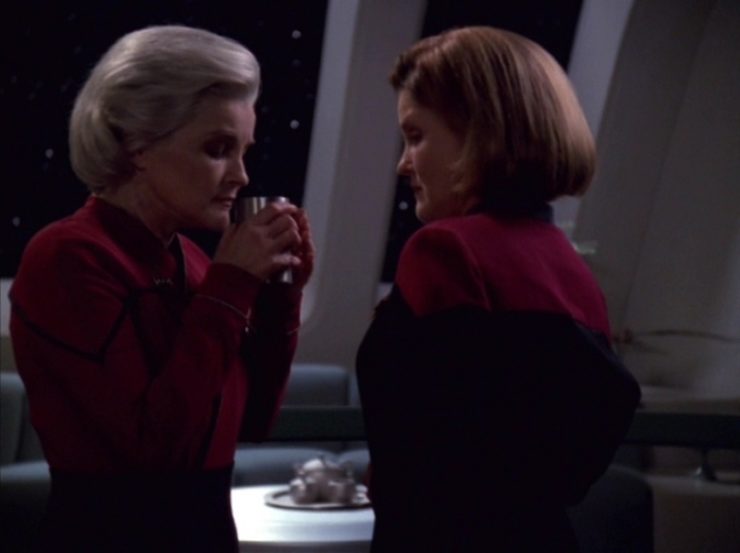
Set a course for home. “You sure I can’t talk you out of this?” I loathed this episode when I watched it in May of 2001, and two decades later, I loathe it even more.
Every other time prior to this that the people on a Star Trek show have gone back in time to change or fix something, it’s almost always been to prevent something horrible, or to reverse a change to something horrible. In the original series’ “The City on the Edge of Forever,” Kirk and Spock had to stop McCoy from saving Edith Keeler so the Nazis wouldn’t win World War II. In First Contact, the Enterprise had to stop the Borg from assimilating twenty-first-century Earth. In DS9’s “Past Tense,” O’Brien and Kira had to go back and rescue Sisko, Bashir, and Dax, after the three of them restored the events of the Bell Riots, so that Earth would still become united. In this very show’s “Timeless,” Kim and Chakotay go back to stop Voyager from being destroyed with all hands lost (save the EMH).
In this episode, though, the future that we see at the top of the episode is not that bad. In fact, it’s pretty good, for the most part. To make matters worse, the script goes ahead and cops to that, as Janeway is confused as to why Admiral Janeway is going to all this trouble to erase a good future.
Worse, somehow Janeway convinced Barclay and Kim to go along with this, and I cannot for the life of me understand how she managed that. When Kim was arguing with her on the shuttle, I was on his side, and yet he goes along with it anyhow, because—I dunno, he’s a doofus or something.
Throughout, the episode is trying to convince us that what’s happening here is a good thing, but in order to do that, it requires the crew to be selfish—an instinct they initially go against, to their credit. But we’re in Admiral Janeway’s POV for so much of the story, and we’re supposed to believe that Seven’s death, Chakotay’s heartbreak, and Tuvok’s deterioration are enough to be worth changing history.
Well, okay, there are also twenty-two other people who will die, but as usual the writers can’t be arsed to give a good goddamn about anyone not in the opening credits. As it is, there is absolutely no mention of the twenty-odd people who’ve died since Voyager left Ocampa. Hell, couldn’t Admiral Janeway have gone back a few weeks earlier, to, say, right before “Friendship One“? Then she would have had more time to convince Janeway and the rest of the efficacy of her plan, plus she could have saved Carey. I mean, c’mon, Chakotay’s heartbreak is important enough to go back in time for, but Carey’s family? Fuck them…
Here’s the thing: this is Star Trek, which at its heart is supposed to be heroic fiction. Our heroes do what’s right, even when their own lives are at risk. Tuvok and Seven make absolutely the right decisions when they agree to go ahead with destroying the hub, and risk life and sanity to do so.
And then the script maddeningly takes another turn to give the crew everything they want without sacrificing any morals, because they do destroy the hub and they do get home, and as usual there are no consequences. Reportedly, they had talked about having someone die in the finale, so that the trip home would have more resonance, but they chickened out there. Not only does nobody die, but it ends with a new life—which is great, in the abstract, and ending the show with Miral’s birth is lovely. But it’s all just too damn easy for everyone.
There’s a time-travel story I didn’t mention above, and it’s worth comparing to this: DS9’s “Children of Time.” Odo in that episode is just like Admiral Janeway, manipulating events for his own selfish reasons, as he wants Kira to live. But in that episode, Odo’s choice was appalling and horrible and one that it took Kira a long time to get past. In this episode, Admiral Janeway is the hero, kind of, and it just leaves a bitter taste in my mouth.
Even if you ignore the very un-Trek-like message of this misbegotten finale, it’s still a big ol’ mess. Bringing the Borg back again was probably as inevitable to the writing staff as bringing back Q was for TNG’s “All Good Things…” But all having the Borg here does is remind us how ineffectual the Borg have become as bad guys, starting very early on when Voyager flies within ten meters of a Borg Cube and the Queen just lets them go for no compellingly good reason. Once again, the Queen is a mustache-twirling villain, this time actively disobeying the Evil Overlord Rules as Admiral Janeway is able to run rings around her in a manner that is totally unconvincing. (“I can beat you because I’m from the future” is extremely weak when we’re talking about the Borg.)
Just as DS9’s “What You Leave Behind” mistook the end of the war for the end of the series, “Endgame” mistakes getting home for the end of the show. There are so many questions that the show either doesn’t answer or pretends to answer by presenting them at the top of the episode, but that’s a future that the show goes out of its way to declare as moot and being erased. How does Starfleet deal with the Maquis, especially in light of the events of the Dominion War? What is the Alpha Quadrant’s response to Seven and Icheb as ex-Borg? (That, at least, is getting some play in Picard, but it took two decades for that to happen…) What is the Alpha Quadrant’s response to the EMH? Does Naomi finally get to meet her father? What’s it like for Tuvok and Kim to be reunited with their families? What is Paris’s reunion with his Dad like?
That last one is particularly frustrating, because Owen is right there on the viewscreen when they fly through the hub, and there’s no dialogue between father and son, not even an acknowledgment that the admiral is about to be a grandfather. Given how fraught the Paris family relationships have been, something that got very specific play in several places (particularly “Persistence of Vision,” “Thirty Days,” and “Pathfinder”), the inability to address this stands out as a particularly big failure in a finale full of them.
One of the other failures that this episode is often dinged for is one that I was actually more predisposed toward this time around: the Chakotay-Seven relationship. While it could’ve been set up better, it was at least a little bit set up in “Human Error.” I like the very meticulous, orderly manner in which Seven approaches dating, and I love what Chakotay says to her when she tried to break up with him.
Ultimately, this finale feels like a rehash of other episodes, whether it’s the gaze into an alternate future (TNG’s “All Good Things…”), going back in time to save people after getting home (“Timeless”), a character giving birth (TNG’s “Disaster”), or the ship surviving an encounter with the Borg completely unscathed against all common sense (“Dark Frontier,” “Unimatrix Zero”).
The only thing “Endgame” got right was to get Voyager home. But contrary to the toast made in 2404 by Barclay and in 2377 by Kim, while the destination was right, the journey there was a total disaster.
Warp factor rating: 1
Keith R.A. DeCandido will be doing a seventh-season overview on Monday, then taking a brief pause before kicking off the Enterprise Rewatch in November.










